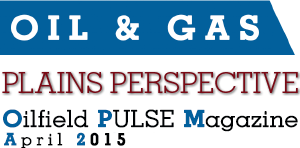The growth of risk management in companies has been staggering in the past few years. The practice itself makes a lot of sense if you are working closely with your supply network.

| Date Published | April 23, 2015 |
| Company | Plains Fabrication |
| Article Author | Chester Nagy |
| Article Type | April 2015 Issue |
| Category | Articles, Oil & Gas |
| Tags | Business Etiquette, E&P, Risk Management Strategy, S&S |
| HUB SEARCH | PlainsFabrication |

The growth of risk management in companies has been staggering in the past few years. The practice itself makes a lot of sense if you are working closely with your supply network.
 I have seen the adage, “You miss 100% of the shots you don’t take,” flying around social media. Risk is a part of life. Getting out of bed and driving to work in the morning is filled with risk. So is lying in bed and pulling the covers over your head every morning. We are surrounded by risk, and we make choices about how to mitigate that risk depending upon our own personal levels of comfort.
I have seen the adage, “You miss 100% of the shots you don’t take,” flying around social media. Risk is a part of life. Getting out of bed and driving to work in the morning is filled with risk. So is lying in bed and pulling the covers over your head every morning. We are surrounded by risk, and we make choices about how to mitigate that risk depending upon our own personal levels of comfort.
When we commute to work, we need to trust in our own ability to operate a vehicle or we rely upon the skill of the bus driver; we need to trust the vehicle has been maintained properly; trust the roads have been maintained properly; and trust the drivers around us are paying attention to the road and not their cellphones. Even though the risks are the same every day, we accept whatever comes our way and return home safely 99.9% of the time. When risk turns into reality, we deal with the situation in the appropriate manner, and life goes on.
 In the business world, there is an ever growing trend to protect against risk and/or to remove all risk. It is no more possible to remove all risk in business than it is on your daily commute. Companies are using their legal departments to create complicated bidding packages and/or purchase agreements. These documents are hundreds of pages long and filled with protectionist language. The growth of risk management in companies has been staggering in the past few years. The practice itself makes a lot of sense if you are working closely with your supply network. If you are keeping everything concise and collaborative, then it will serve all the companies involved well to recognize and identify possible risk. The issue is many companies are using these documents to protect themselves rather than using them to identify risk. These large documents are attempting to divert all risk down the supply network.
In the business world, there is an ever growing trend to protect against risk and/or to remove all risk. It is no more possible to remove all risk in business than it is on your daily commute. Companies are using their legal departments to create complicated bidding packages and/or purchase agreements. These documents are hundreds of pages long and filled with protectionist language. The growth of risk management in companies has been staggering in the past few years. The practice itself makes a lot of sense if you are working closely with your supply network. If you are keeping everything concise and collaborative, then it will serve all the companies involved well to recognize and identify possible risk. The issue is many companies are using these documents to protect themselves rather than using them to identify risk. These large documents are attempting to divert all risk down the supply network.

The growth of risk management in companies has been staggering in the past few years. The practice itself makes a lot of sense if you are working closely with your supply network.
Good relationships are built upon trust. A relationship requires open honest dialogue. A contract is a relationship between two companies. It should be a bond between customer and supplier, and we should be trying to produce a product that will lead to a long term relationship. Creating a document which acts as a shield will not help create a successful project nor build a long term trusting relationship.
If all parties come to the table willing to share some of the burden of risk involved in the project, it creates the right environment for successful outcomes. If the project is adversarial from the start, I think it is obvious the lack of trust can create unwanted scenarios and no one wins.
Don’t get me wrong. This is not about hurt feelings. A lot of the words I am using could be misconstrued as being soft or “touchy feely”. Ultimately, we are trying to create value for all the players involved in the game. If your view is every contract has winners and losers, my experience tells me that mindset is detrimental to good business. If we share in the risk and we trust each other to produce a mutually beneficial outcome, then my years running a successful business should be all the proof you need.
Perhaps this will be viewed as a little old fashioned by some, but there was a time when deals were done on a handshake. A person was as good as their word; honor and respect were perhaps viewed a little differently than they are today. The world of business is ever changing and constantly evolving. Change is not always bad. In fact, continuous improvement practices mean everything should evolve. New methods of business are created in response to prevailing issues. That is perfectly logical, but sometimes, we over react. That is what I think has happened in this case. Businesses have grown and sometimes, new methods are needed to ensure a company is protected. What I am trying to say here is the balance has shifted too far in the other direction. We have gone from a handshake to legal documents that are hundreds of pages long and create a system of mistrust. Without trust and the willingness to share risk as business owners, we are not creating an environment for mutual success.
 More and more companies are coming to this realization, and the relationships we are building with our customers are getting better all the time. I have a feeling the face to face meetings and the handshake are still pretty meaningful. We are working closely with our customers to try to find the right balance.
More and more companies are coming to this realization, and the relationships we are building with our customers are getting better all the time. I have a feeling the face to face meetings and the handshake are still pretty meaningful. We are working closely with our customers to try to find the right balance.